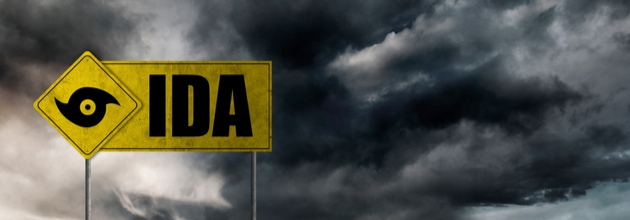 | Read in Browser |
 |
 |
| | Top News  Shutterstock Hurricane Ida slammed into Louisiana as a Category 4 storm on Sunday, lashing the coast with 150 mile-per-hour winds, torrential downpours and life-threatening storm surges. By nightfall, power was knocked out to the entire New Orleans metropolitan area, according to Entergy (NYSE: ETR), with the failure of all eight transmission lines that deliver electricity to Louisiana's largest city. The pounding surf even submerged much of the shoreline under several feet of water and reversed the flow of the Mississippi River. The cost of the storm could exceed $40B and will test the flood defenses installed after Hurricane Katrina in 2005. Ironically, Ida came ashore on the 16th anniversary of Katrina's landfall, which left the region in shambles and killed more than 1,800 people. Ida has also triggered concerns about hospitals in New Orleans, which are reeling from a fourth wave of COVID-19 patients, though hundreds of emergency responders are in place, as well as the U.S. Army Corps of Engineers to assist in power restoration. Energy on watch: WTI crude prices ( CL1:COM) neared $70/barrel in anticipation of the storm on Sunday, but dropped to $68 overnight as Ida was downgraded to a Category 1 storm on the five-step Saffir-Simpson scale. However, 95% of total U.S. oil and gas production in the Gulf Coast region is still offline, prompting natural gas and gasoline futures to rise, with the "worst case scenario of Ida adding 10 cents to 20 cents to the price of a gallon of gas through September," per Mark Zandi, chief economist at Moody's Analytics. Offshore wells in the area account for 17% of total U.S. crude production and 5% of dry natural gas output, while more than 45% of total U.S. refining capacity is along the Gulf Coast. Impact on the economy? Zandi may shave his forecast for GDP growth in the current quarter by a few tenths of a percentage point, but will likely add the loss back in the fourth quarter growth due to the rebuilding from the storm damage. For the second half of the year, he also expects GDP to expand by 6.5%, matching the average growth seen in the first six months of 2020. "The key channel for Ida to impact the broader economy is through energy prices," Zandi declared. "We will have to see how much damage occurred to production in the Gulf and how long that production will stay offline." ( 23 comments) | | Stocks U.S. stock index futures continue to point green, albeit slightly, following an eventful meeting in Jackson Hole on Friday. Investors were quick to highlight the dovish stance of Fed Chair Jerome Powell, who said he was in no rush to raise rates and would be guided by data and risks posed by the Delta variant. That effectively shut out noise from several Fed speakers who had made some hawkish noises within the same time frame. Powell also continued to make the case that inflationary pressures were "transitory" and there had been "clear progress" toward maximum employment. While the Fed may start paring its bond purchases in the next few months, Powell didn't give a specific timeline for scaling back stimulus, and even if it comes this year, it won't necessarily start the shot clock on hiking interest rates. Traders took the news in stride, with a fresh round of stock market highs. Quotes: "The central bank has been able to successfully divorce the idea of 'tapering' from interest rate hikes in order to avoid a repeat taper tantrum," wrote Tracy Alloway at Bloomberg, while the WSJ's Jon Hilsenrath expressed similar sentiment: "The Fed has done a better job of preparing investors for a shift in its policies than it did in 2013 and the market largely agrees with its approach." Risks remain: If inflation persists longer than anticipated or if the pressures continue to escalate, the Fed might have to throw out its gradual approach to normalizing monetary policy. That could see a swifter pace of interest rate increases and spark a flashback of 2013. Last time around, there was a two-year gap between when the Fed started winding down QE and when it began upping rates, however, the current time frame could demand a much shorter gap given the sharp rebound in the U.S. economy. ( 5 comments) | | Sponsored By Yieldstreet  Back in the '80s, interest rates on savings accounts hit historic highs, topping out well over 10%. But not everything is as it was in the '80s. With inflation rising and CD rates flirting with zero, savings accounts are about as fashionable as shoulder pads and neon spandex. Fortunately, Yieldstreet is here to help put your savings to work, serving up a marketplace of alternative investments to help kickstart your passive income: - With asset classes ranging from real estate to legal finance, Yieldstreet's investments can help deliver valuable diversification to your investment portfolio.
- And Yieldstreet offers a selective process to bring investments to their community 一 just 4% of deals made it past the company's due diligence process last year.
Here's The Kicker: Yieldstreet offers target annual yields typically in the of up to 7% to 15% range, allowing you to shift into leisure mode while your money is positioned to works overtime. Learn more about how Yieldstreet can start your passive income journey today. | | IPOs Rivian (RIVN) has reportedly filed for an IPO and is looking to go public around Thanksgiving after it lands SEC approval. According to Bloomberg, the electric vehicle startup is looking for a valuation of around $80B, which is an astounding jump from the $27.6B valuation when it raised new funds from T. Rowe Price, Fidelity Investments and Amazon (AMZN) at the beginning of the year. Ford (F) was also an early investor in Rivian.
Sticker shock: The $80B valuation is higher than the market caps of Nio (NIO) $61B, Fisker (FSR) $4B, Canoo (GOEV) $2B, Workhorse Group (WKHS) $1.1B and Lordstown Motors (RIDE) $1.1B - combined.
Last month, Rivian founder RJ Scaringe told customers he expected the company's truck to ship in September (following supply chain delays) and its highly anticipated SUV to follow soon after. The R1T truck will have an over 300-mile range when it launches, while the R1S SUV will feature towing capacity of 7,700 pounds. Amazon is also tied pretty close to Rivian with a goal to have a delivery fleet of 10,000 Rivian vehicles on the road making deliveries by 2030.
Analyst commentary: "Rivian is one of the best-positioned electric vehicle start-ups," said Asad Hussain, senior mobility analyst at PitchBook. "The company's focus on the relatively untapped premium electric truck market should allow it to gain rapid market adoption." (200 comments)
| | Trending In a potential blow to the travel industry, the European Union today is expected to recommend that member states reinstate COVID-related travel restrictions and halt nonessential travel from the U.S. That could mean quarantine and testing requirements for unvaccinated travelers, sources told the WSJ. EU officials have been debating the move for much of the last month, with the average U.S. infection rate now above that of the EU.
Fine print: EU countries are not obligated to follow the EU Safe Travel List, which is reviewed every two weeks. However, the list has generally set the pattern over the past few months for who can visit the bloc.
The European Union lifted travel restrictions for U.S. visitors in June, shortly after President Biden visited Brussels to speak with EU leaders. The motion was seen as an effort to reset transatlantic relations, and at the time, European officials said Biden's team told them they would make it a priority to lift the ban on EU visitors. The latter never arrived, and in early in August, European Commission President Ursula von der Leyen warned that the bloc wouldn't allow the lack of reciprocity to "drag on for weeks."
Outlook: Flights between the U.S. and Europe soared after Europe reopened its doors to American visitors at the start of July, especially for visits to Spain and Portugal, according to aviation analytics firm Cirium. EU countries are also eager to keep their doors open during the summer tourist season to bring in whatever revenue they can during the pandemic. | | Today's Markets In Asia, Japan +0.5%. Hong Kong +0.5%. China +0.2%. India +1.4%.
In Europe, at midday, London closed. Paris +0.1%. Frankfurt +0.2%.
Futures at 6:20, Dow +0.1%. S&P +0.1%. Nasdaq +0.2%. Crude -1.1% at $68.01. Gold -0.1% at $1818.30. Bitcoin -1.2% at $47932.
Ten-year Treasury Yield -1 bps to 1.3%
Today's Economic Calendar | | | | | | | | Seeking Alpha's Wall Street Breakfast Podcast Seeking Alpha's Wall Street Breakfast podcast brings you all the news you need to know for your market day. Released by 8:00 AM ET each morning, it is a quick listen that you can put on as you get ready to start your working day. | | | | |











EmoticonEmoticon